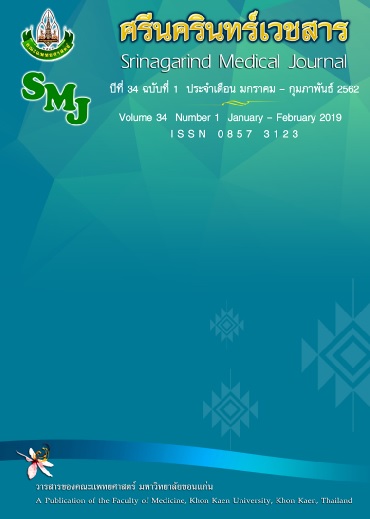Prevalence of Anatomical Variations of Biliary Tree on MRCP among Patients in Srinagarind Hospital
Keywords:
variations in biliary anatomyAbstract
Background and Objective: The growing recognition and awareness of hepatobiliary disease as led to increase the number of surgical procedures being conducted. Appropriate knowledge of biliary tract anatomic variants is crucial in order to reduce bile duct injuries during surgery. This study aimed to the variations in biliary anatomy in the general population of northeast Thailand using magnetic resonance cholangiopancreatography (MRCP).
Method: Three hundred and eighty-seven patients were examined by MRCP at Srinagarind Hospital between Nov 2nd, 2012 and Nov 5th, 2013. All MRCP images were reviewed and the biliary anatomy was classified by two radiologists according to the Couinaud classification system. The interobserver agreement was analyzed using a Kappa agreement score.
Result: The prevalence of typical duct anatomy (type A) was 74.4% (n=288), and that of variation from the conventional pattern was 25.6% (n=99). Type B (or trifurcation) was found in 34 patients (8.8 %). The frequencies of other types were as follows: type C1, 0.3 % (n= 1); type C2, 3.1% (n=12); type D1, 6.2% (n= 24); type D2,1.3% (n=5); type E1, 0% (n=0); type E2, 0.5 % (n=2); and type F, 0% (n=0). The remaining 21 patients (5.4 %), all of whom had accessory hepatic ducts, were classified as “other variations.” The Kappa agreement of MRCP readings by two radiologists was 0.431 (p value <0.001).
Conclusion: There was variation from the typical pattern in 25.6% of cases. This study showed that MRCP is a non-invasive tool that can be used to evaluate anatomical variations of the intraheptatic ducts before surgical procedures.
References
2. Thungsuppawattanakit P, Arjhansiri K. Anatomic variants of intrahepatic bile ducts in Thais. Asian Biomedicine 2012; 6: 51-7.
3. Mortele KJ, Ros PR. Anatomic variants of the biliary tree: MR cholangiographic findings and clinical applications. AJR Am J Roentgenol 2001; 177: 389-94.
4. Basaran C, Agildere AM, Donmez FY, Sevmis S, Budakoglu I, Karakayali H et al. MR cholangiopancreatography with T2-weighted prospective acquisition correction turbo spin-echo sequence of the biliary anatomy of potential living liver transplant donors. AJR Am J Roentgenol 2008; 190: 1527-33.
5. Kapoor V, Peterson MS, Baron RL, Patel S, Eghtesad B, Fung JJ. Intrahepatic biliary anatomy of living adult liver donors: correlation of mangafodipir trisodium-enhanced MR cholangiography and intraoperative cholangiography. AJR Am J Roentgenol 2002; 179: 1281-6.
6. Vitellas KM, Keogan MT, Spritzer CE, Nelson RC. MR cholangiopancreatography of bile and pancreatic duct abnormalities with emphasis on the single-shot fast spin-echo technique. Radiographics 2000; 20: 939-57; quiz 1107-8, 1112.
7. Chamadol N, Pairojkul C, Khuntikeo N, Laopaiboon V, Loilome W, Sithithaworn P et al. Histological confirmation of periductal fibrosis from ultrasound diagnosis in cholangiocarcinoma patients. J Hepatobiliary Pancreat Sci 2014; 21(5):316-22.
8. Mariolis-Sapsakos T, Kalles V, Papatheodorou K , Goutas N, Papapanagiotou I, Flessas I et al. Anatomic variations of the right hepatic duct: results and surgical implications from a cadaveric study. Anat Res Int 2012; 2012: 838179.
9. Choi JW, Kim TK, Kim KW, Kim AY, Kim PN, Ha HK et al. Anatomic variation in intrahepatic bile ducts: an analysis of intraoperative cholangiograms in 300 consecutive donors for living donor liver transplantation. Korean J Radiol 2003; 4: 85-90.
10. Deka P, Islam M, Jindal D, Kumar N, Arora A, Negi SS. Analysis of biliary anatomy according to different classification systems. Indian J Gastroenterol 2014; 33: 23-30.
11. Ronald S. Chamberlain (2013). Essential Functional Hepatic and Biliary Anatomy for the Surgeon, Hepatic Surgery, Prof. Hesham Abdeldayem (Ed.), ISBN: 978-953-51-0965-5, InTech, DOI: 10.5772/53849.
12. Landis JR, Koch GG. The measurement of observer agreement for categorical data. Biometrics 1977;
33: 159–74.
13. Ohkubo M , Nagino M , Kamiya J , Yuasa N , Oda K, Arai T et al. Surgical anatomy of the bile ducts at the hepatic hilum as applied to living donor liver transplantation. Annals of Surgery 2004; 239: 82-6.




